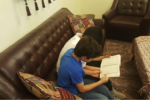Trigger warning: mention of sexual harassment/abuse, violence against children, Islamophobia and gendered violence. The video in question has not been linked.
On November 9th, a video of girl’s hijab being ripped off in class began circulating around internet. Apparently, the young woman’s teacher posted the video on his Snapchat account, though she later denied posting the video. The first clip included the caption, “pretty hair,” while the second was captioned, “lol, all that hair cover [sic] up!!!”
I refuse to link to any articles reporting the incident because they all show the video without censoring the girl’s hair and, quite likely, without the girl’s consent. None of the articles I read mentioned the student’s name (though they do mention that she attended New Vision Academy Charter School), and most of her face isn’t shown in the video. Because of this, those who do not know her personally probably would not be able to recognize her. Still, out of respect for her, her choice to wear hijab and her right not to be shown in a viral video experiencing abuse and violence at the hands of her peers, I will not link to the original report. This video is one of the latest examples of how graphic violence against racialized bodies is consumed by spectators through mainstream media outlets. Hence, I do not want to contribute to the spreading of this video against her will.
There’s also another reason I’m choosing not to share the video: it’s painfully triggering. When I first saw the video, I cried. I know all too well what it feels like to have uninvited hands exploring my body, and it’s beyond heartbreaking that this middle schooler experienced it at such a young age. By now it’s no secret that children are frequently the subjects of sexual harassment. The #metoo campaign further reminded us that sexual harassment and sexual abuse are pretty much a societal norm in many countries. These facts don’t make the idea any less repugnant or the event any less traumatic.
Some may not consider the act of ripping the girl’s scarf off to be sexual harassment, but there are two reasons I’m qualifying it as such. Firstly, according to the University of Michigan’s Sexual Assault Prevention and Awareness Center, “unwanted physical or sexual advances” are considered examples of sexual harassment. These advances include “touching, fondling… or other sexual activity.” The UN’s Women Watch released a paper with similar language. Notably, the UN definition explicitly includes “touching…clothing, hair, or body” in their definition of sexual harassment.
In the video, the young woman is slouching in her chair and slightly turned away from the camera. Her hands are covering her face while she attempts to keep the scarf from coming off. In the next clip, we see the girl hastily attempting to put her scarf back on as other students touch her head and play with her hair (effectively preventing her from putting her scarf back on). The girl’s body language tells us that while her teacher filmed the video, she was uncomfortable being touched. Further, it looks like she did not want to be filmed, and she was probably not consulted when the video was posted on social media. Hence, the girl was not only violently bullied by her peers and her teacher, but the media violated her privacy and personal sovereignty.
Second, sexual harassment/abuse is rarely about sex; it’s about power. The abuser seeks to exert dominance over the abused. In this case, the teacher exerted further authority over the student than what she already had by ripping the student’s scarf off. She (the teacher was a woman) also exercised dominance by encouraging or allowing other students to play with the young woman’s hair and body without her consent. In that moment, the young woman was outnumbered and had no allies to call on. The video shows students of various races reaching out to touch her hair, but in the footage none of them helped her.The teacher’s actions not only taught the students that it is acceptable to bully people for their race, religion, gender and culture, but also taught them that racialized women’s bodies are objects of consumption. Also, at the personal level, by harassing this young woman, the students gained access to a hijabi’s concealed hair by violating her personal sovereignty, something that wasn’t theirs to take.

Image with permission of Imanita Song- via Instagram.
The teacher who posted the videos was eventually suspended without pay. She has consistently denied posting the videos, though she has yet to deny filming the video or initiating the incident. While the suspension may be indicative of some action to address the issue, it is inconsistent with similar instances of violence. Last May, a substitute teacher in the Bronx, who removed a student’s hijab, was fired for doing so. The teacher was further named in the media and some of his pictures have been circulated online. The New Vision Academy teacher’s name has neither been released by the media, nor have her pictures been shared. In fact, many articles posted in mainstream media outlets go out of their way to identify the teacher in any way, to the point that it took a lot of digging figuring out if the teacher was a man or a woman.
To date, there is also no information about whether the students who contributed to the bullying will be punished. Instead, the school’s administration has released a statement saying they will use the video to “promote cultural sensitivity and awareness.” One hopes that they do not use the video itself, but the incident as an example. People shouldn’t need a video of a racialized Muslim girl experiencing violence to understand that violence is wrong. Given the fact that violence against racialized bodies has been normalized in many settings and transformed into “goods” for consumption, one wonders if a white teenager filmed in a similar situation would ever be used as “training” material. In fact, were she not a racialized young woman, the video would have most likely been petitioned for removal by law enforcement officials or concerned citizens. Remember, this is a video of a racialized Muslim minor experiencing violence; it has no business being on the Internet.
Further, based on some of the media coverage, the school sees this as an issue of lack of cultural sensitivity, though the teacher stated that the scarf was not removed out of disrespect for the student. Clearly, lack of cultural awareness is not the problem here. If the action isn’t the result of a misunderstanding or lack of cultural awareness (neither of which would justify her actions), then it is likely that the purpose was to humiliate the student. Forcibly removing someone’s clothing for reasons other than emergent medical necessity (i.e. emergency medical services determining removing one’s clothing is necessary to save one’s life) is never acceptable.
Whereas the teacher was exerting power and perpetrating violence over this single student’s body, governments and societies around the world have been policing and violating women’s bodies for millennia. If a woman wears makeup she’s vapid, but if she doesn’t she’s a slob. If a woman is assaulted while wearing a miniskirt, she was asking for it. These little bits of “advice” are so ingrained in us that we are always running risk analyses in the back of our heads. In terms of Muslim women, governments are not only policing what we wear, but also creating narratives about us that diminish our agency. They brand Muslim men as terrorists and relegate women to the role of submissive wife or brainwashed girlfriends who need saving. Alternatively, Muslim women’s clothing, activities, social roles, etc. are often at the forefront of political discourses. Muslim girls are also faced with the politics of hijab and niqab in educational settings and exposed to violence at hands of their peers and the very people that supposedly are there to protect them. These policies and institutions often (try to) take agency away from Muslim women.
Gendered violence seems to be built into the fabric of some societies. In the past little while, however, we are seeing more and more people in positions of power, being forced to face the consequences of their inappropriate behavior in countries like the US. At least to some degree. This may indicate that we are more open to no longer tacitly accepting sexual harassment. Of course, there is still a long way to go. Racialized women and those in the LGBTQ* community who suffer and report abuse still go largely unheard. We trust caretakers such as doctors and teachers to protect our children, but in the case of the New Vision Academy Charter School student, her caretaker was the very person who violated her. So I wonder, how will we secure justice and the right to personal sovereignty for those whose caretakers perpetuate violence against them? How will we protect racialized Muslim children who may be in oppressive situations in school settings? And when will we stop normalizing violence against Muslim women in all its forms?
____
*As a middle school student, her age likely falls below the legal age of sexual consent in the United States and Canada, with a few close-in-age exemptions. Even if she were legally able to verbally consent, there’s no guarantee that the consent wouldn’t be the result of coercion. In order for consent to be legally viable, it must be freely and enthusiastically given. Consenting out of fear does not qualify as consent. People also have the power to revoke their consent at any moment. Assuming she was of legal age and willingly consented, that doesn’t mean her consent couldn’t be taken back. However, the stress of the situation may have prevented her from verbally revoking consent. There’s a summary of rape, sexual harassment, and consent in The Independent. There’s a list of truths and misconceptions about sexual assault on the University of Michigan’s Sexual Assault Prevention and Awareness Center.



